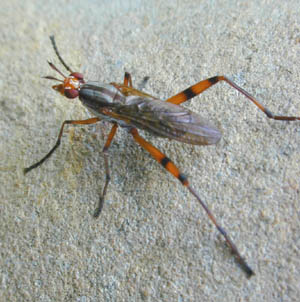
The Acalyptratae or Acalyptrata are a subsection of the Schizophora, which are a section of the order Diptera, the "true flies". In various contexts the Acalyptratae also are referred to informally as the acalyptrate muscoids, or acalyptrates, as opposed to the Calyptratae. All forms of the name refer to the lack of calypters in the members of this subsection of flies. An alternative name, Acalypterae is current, though in minority usage. It was first used by Pierre-Justin-Marie Macquart in 1835 for a section of his tribe Muscides; he used it to refer to all acalyptrates plus scathophagids and phorids, but excluding Conopidae.

Milichiidae are a family of flies. Most species are very small and dark. Details of their biology have not yet been properly studied, but they are best known as kleptoparasites of predatory invertebrates, and accordingly are commonly known as freeloader flies or jackal flies. However, because of the conditions under which many species breed out, they also are known as filth flies.
A facultative parasite is an organism that may resort to parasitic activity, but does not absolutely rely on any host for completion of its life cycle.
Diptera is an order of winged insects commonly known as flies. Diptera, which are one of the most successful groups of organisms on Earth, are very diverse biologically. None are truly marine but they occupy virtually every terrestrial niche. Many have co-evolved in association with plants and animals. The Diptera are a very significant group in the decomposition and degeneration of plant and animal matter, are instrumental in the breakdown and release of nutrients back into the soil, and whose larvae supplement the diet of higher agrarian organisms. They are also an important component in food chains.
Argyrotaenia bisignata is a species of moth of the family Tortricidae. It is found in the Dominican Republic.
Pyrausta bisignata is a moth in the family Crambidae. It was described by Arthur Gardiner Butler in 1889. It is found in the north-western Himalayas.

Heliocypha bisignata, stream ruby, is a species of damselfly in the family Chlorocyphidae. It is endemic to South India where it breeds in hill streams in the southern part of the country.

Milichiella is a genus of freeloader flies in the family Milichiidae.
Aldrichiomyza agromyzina is a species of freeloader fly in the family Milichiidae.
Aldrichiomyza is a genus of freeloader flies in the family Milichiidae. There are about six described species in Aldrichiomyza.
Desmometopa varipalpis is a species of freeloader fly in the family Milichiidae. It is found in Europe.
Milichiella lacteipennis is a species of freeloader flies in the family Milichiidae.
Phyllomyza milnei is a species of freeloader flies in the family Milichiidae.
Phyllomyza is a genus of freeloader flies in the family Milichiidae. There are at least 30 described species in Phyllomyza.
Eusiphona mira is a species of freeloader flies in the family Milichiidae.
Eusiphona is a genus of freeloader flies in the family Milichiidae. There are at least four described species in Eusiphona.
Leptometopa latipes is a species of freeloader flies in the family Milichiidae.
Pholeomyia indecora is a species of freeloader fly in the family Milichiidae.
Milichiella arcuata is a species of freeloader flies in the family Milichiidae.
Paramyia nitens is a species of freeloader flies in the family Milichiidae.




